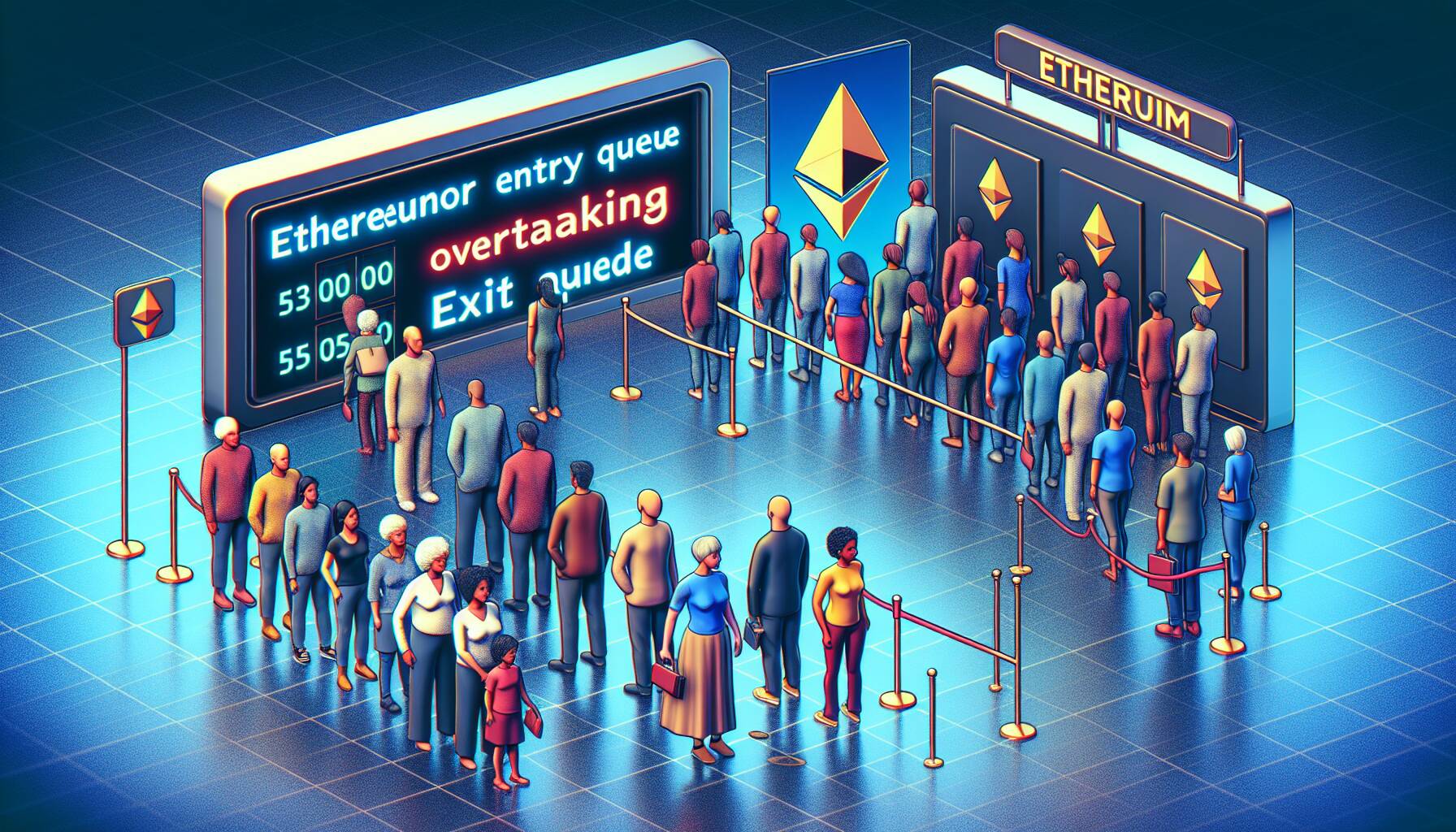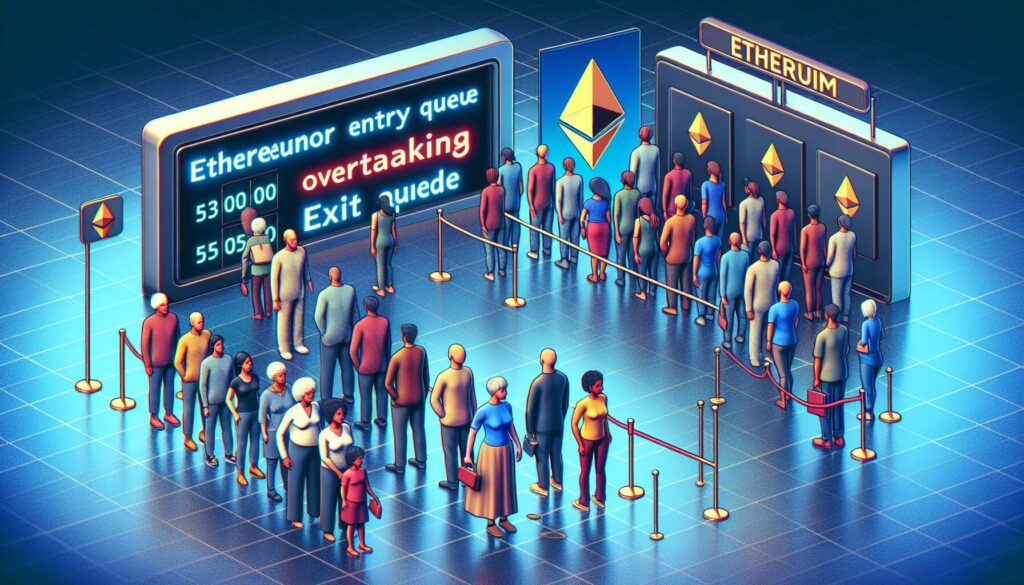In a significant shift within the Ethereum landscape, the validator entry queue has recently surpassed the exit queue for the first time in weeks, indicating a rising interest in staking ether (ETH) amidst a calming market atmosphere. Currently, approximately 932,936 ETH, equivalent to about $4 billion, is queued for entry, while the exit queue holds 791,405 ETH valued at $3.3 billion, as highlighted by data from validatorque.com.
This notable turnaround follows a period of concern three weeks ago when the exit queue peaked at 816,000 ETH, raising alarms about the market’s capacity to absorb potential sell pressures once substantial amounts of the cryptocurrency were unlocked. A pivotal factor contributing to this renewed demand was the unexpected re-engagement of an Ethereum ICO participant who had remained inactive for eight years. This long-term holder recently moved an impressive 150,000 ETH, valued at $645 million, into staking, revitalizing interest in the asset.
The investor famously acquired 1,000,000 ETH for a mere $310,000 during Ethereum’s 2014 token sale, and even after staking, their wallet maintains a substantial 105,000 ETH, roughly $451 million, across two accounts.
Despite facing a 4% decline since mid-August, when the exit queue was at its highest, Ethereum has largely avoided the drastic sell-offs many had anticipated, contrasting with Bitcoin’s 7% drop and double-digit declines in various altcoins. This resilience speaks to the ongoing strength and appeal of Ethereum’s proof-of-stake system, which appears to function as both a stabilizing mechanism and an attractor for new capital.
As the atmosphere shifts, the ramifications of these changes signal a possible tilt back toward long-term staking as a strategic investment in Ethereum’s future, particularly in light of growing structural demand potentially spurred by ETF inflows, as noted by DeFi analysts. The balance is indeed beginning to tip, presenting a landscape rich with evolving opportunities in the Ethereum ecosystem.

Ethereum Staking Demand Surges
Key Points to Consider:
- Validator Entry Queue Growth: The entry queue for Ethereum staking has surpassed the exit queue, indicating a rise in demand for staking ether (ETH).
- Current Statistics: As of now, 932,936 ETH ($4 billion) is in the entry queue, compared to 791,405 ETH ($3.3 billion) in the exit queue.
- Resurfacing of a Major Investor: A participant from Ethereum’s ICO has staked 150,000 ETH ($645 million) after nearly eight years, signaling long-term confidence in ETH.
- Nervousness Eases: The market has shown resilience; although there was once concern over potential sell pressure, the 4% decline in ETH since mid-August has been less severe than anticipated.
- Long-Term Staking Confidence: The shift in queue dynamics emphasizes confidence in Ethereum’s proof-of-stake system and potential long-term rewards.
- Impact of ETFs: Structural demand for Ethereum may be influenced by ETF inflows, reinforcing the confident sentiment towards staking as a long-term investment strategy.
“While the unstaking queue is at ATH, so are ETF inflows.” – DeFi analyst Ignas
Ethereum Staking Dynamics: A Comparative Perspective
The recent surge in Ethereum’s validator entry queue, overtaking the exit queue, underscores a pivotal shift in the market that may signal growing investor confidence. This contrasts sharply with the cautious sentiment observed just weeks ago, drawing a notable parallel to trends in other major cryptocurrencies like Bitcoin (BTC). As Ethereum made headlines with $4 billion in stakes against $3.3 billion in exits, it prompts a closer examination of similar dynamics in the crypto space.
Competitive Advantages: Ethereum’s current resurgence in staking highlights a renewed appetite among investors for long-term growth, leveraging the potential benefits of proof-of-stake mechanisms. This strategy not only shores up Ethereum’s ecosystem but also attracts institutional capital, particularly with reports of significant capital inflows from ETFs. Investors looking for sustainable returns may find Ethereum’s staking model attractive compared to the more volatile nature of BTC and other altcoins, which have experienced steeper declines. Furthermore, the narrative of the significant ICO whale re-entering the staking game adds a layer of market validation and can enhance confidence among retail investors.
Competitive Disadvantages: However, the Ethereum market is not without risk. The fact that the exit queue had previously peaked at an all-time high raises concerns about potential profit-taking once Ethereum experiences upward price momentum. Moreover, while Ethereum’s staking rewards may appear lucrative now, the inherent volatility of crypto markets may deter risk-averse investors. They may opt for more stable digital assets or traditional investments, especially amid uncertainties surrounding macroeconomic conditions and regulatory scrutiny in the crypto sector.
The implications of these developments are profound. Long-term investors seeking to capitalize on Ethereum’s staking rewards are likely to benefit, particularly as confidence builds around staking as a more stable income source in the midst of a turbulent market. Conversely, short-term traders and those trapped in the previous sell-off may face challenges if the anticipated upward momentum fails to materialize, potentially leading to liquidity issues. Moreover, competitors in the altcoin arena might find themselves under pressure, as Ethereum’s staking opportunities can divert attention and capital away from them, posing challenges to their market positioning.

















